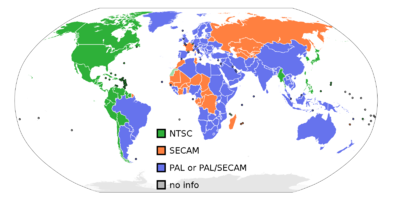PAL: Difference between revisions
m (→See also) |
No edit summary |
||
| Line 1: | Line 1: | ||
{{ArticleIcons| | {{ArticleIcons|allgames=y}} | ||
{{stub}} | |||
[[File:PAL-NTSC-SECAM.png|thumb|400px|Regions of the world which used the different encoding systems]] | [[File:PAL-NTSC-SECAM.png|thumb|400px|Regions of the world which used the different encoding systems]] | ||
'''Phase Alternate Line''', often referred to as '''PAL''', was an analogue television encoding system used in Europe, Australia, Africa and parts of South America. While it has been made obsolete by the use of digital component encoding, the term survives as a colloquial reference to the version of games and other televisual media released in the former PAL regions, particularly Europe and Australia. | |||
'''PAL''' | |||
==Regional differences== | ==Regional differences== | ||
{{main|List of regional version differences (SSB)|List of regional version differences (SSBM)|List of regional version differences (SSBB)}} | {{main|List of regional version differences (SSB)|List of regional version differences (SSBM)|List of regional version differences (SSBB)}} | ||
Both ''[[Super Smash Bros. Melee]]'' and ''[[Super Smash Bros. Brawl]]'' were released in the NTSC regions of Japan and North America prior to PAL regions; in this "gap" between releases, both games were modified slightly in order to both adjust them for regional reasons, such as changing languages or information relating to release dates, or gameplay fixes, such as fixing [[glitch]]es or changing properties of specific attacks. | |||
== See also == | == See also == | ||
* [[NTSC]] | * [[NTSC]] | ||
* [[wikipedia:PAL|Wikipedia's PAL article]]. | * [[wikipedia:PAL|Wikipedia's PAL article]]. | ||
[[Category:Game regions]] | [[Category:Game regions]] | ||
Revision as of 12:36, February 16, 2014
Phase Alternate Line, often referred to as PAL, was an analogue television encoding system used in Europe, Australia, Africa and parts of South America. While it has been made obsolete by the use of digital component encoding, the term survives as a colloquial reference to the version of games and other televisual media released in the former PAL regions, particularly Europe and Australia.
Regional differences
Both Super Smash Bros. Melee and Super Smash Bros. Brawl were released in the NTSC regions of Japan and North America prior to PAL regions; in this "gap" between releases, both games were modified slightly in order to both adjust them for regional reasons, such as changing languages or information relating to release dates, or gameplay fixes, such as fixing glitches or changing properties of specific attacks.

